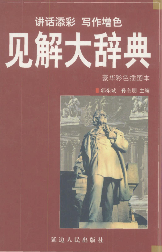
主要责任者: 郭东斌,孙奎朋;苗丰仁,林建公,陈玉潮等
责任方式: 主编;副主编
出版者: 延边人民出版社
出版地: 延吉
字数: 1100 千字
页码: 1-880
开本: 32
中图分类号: H164
装帧: 精
语种:中
定价:98.00
出版时间:2002-06
丛书多卷书否:否
书目简介:本册工具书共收录2758条词条。
被引频次:3
| 词条 | 见解大辞典 |
| 类别 | 中文百科知识 |
| 释义 |  主要责任者: 郭东斌,孙奎朋;苗丰仁,林建公,陈玉潮等 责任方式: 主编;副主编 出版者: 延边人民出版社 出版地: 延吉 字数: 1100 千字 页码: 1-880 开本: 32 中图分类号: H164 装帧: 精 语种:中 定价:98.00 出版时间:2002-06 丛书多卷书否:否 书目简介:本册工具书共收录2758条词条。 被引频次:3 |
| 随便看 |
开放百科全书收录579518条英语、德语、日语等多语种百科知识,基本涵盖了大多数领域的百科知识,是一部内容自由、开放的电子版国际百科全书。